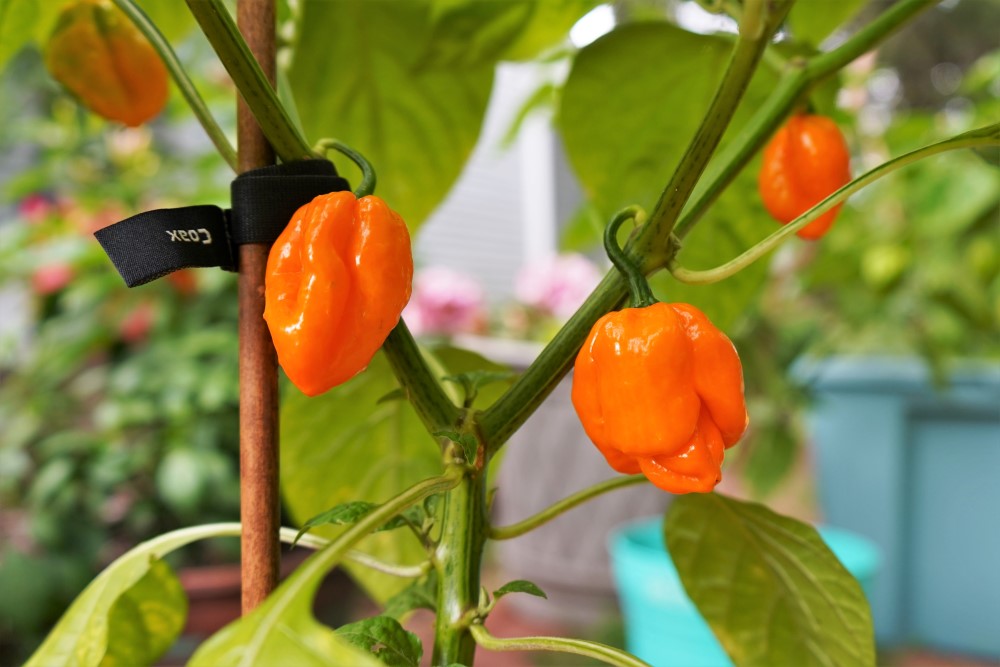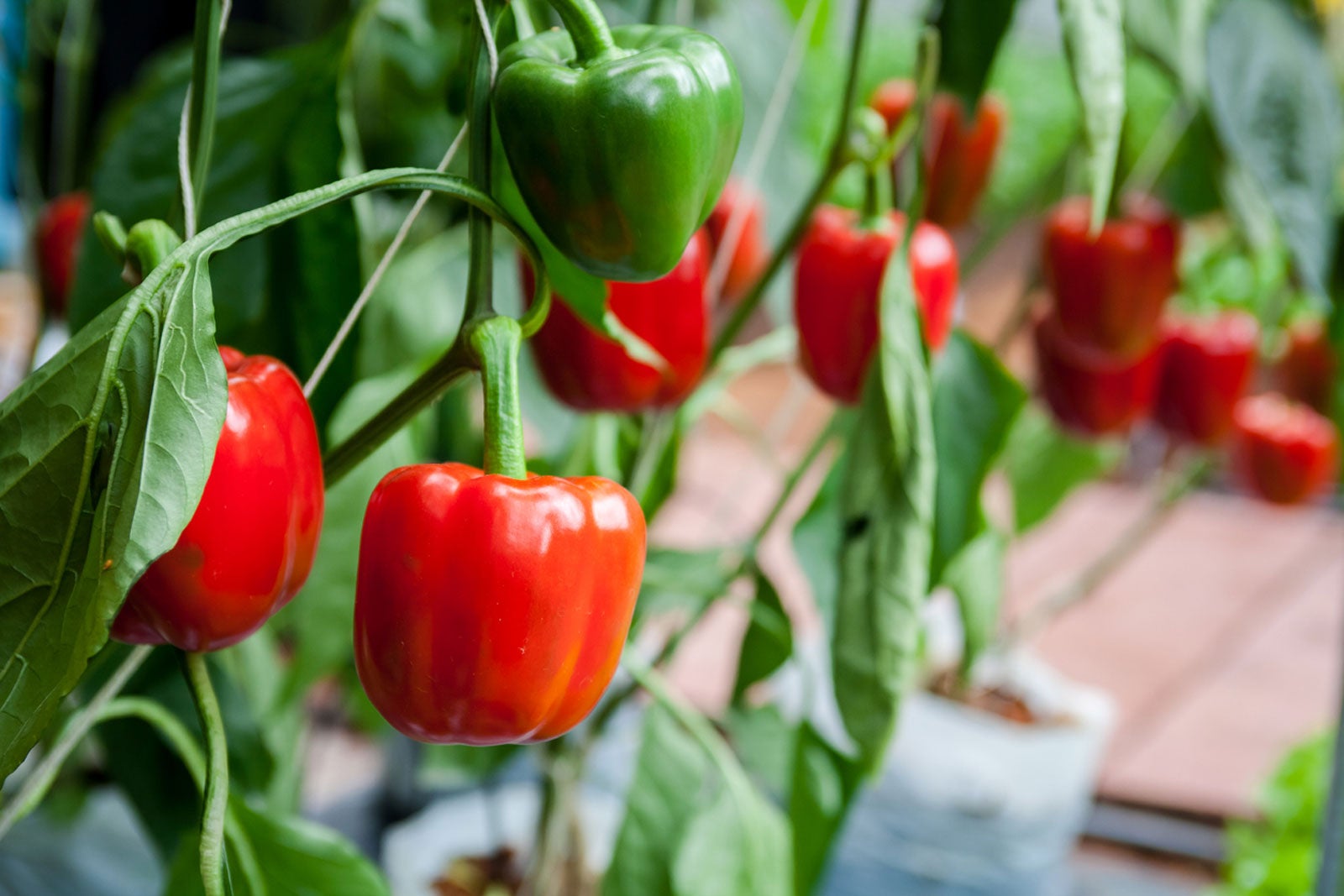People who have never grown peppers before may want to know how long it takes for them to grow. Peppers take longer to grow than many other common vegetable crops.
Peppers aren’t the best plant for a short growing season, but the longer wait is well worth it for the tasty result (okay, I might be biased…).
So, in this article, you’ll learn how long peppers take to grow from seed to harvest.
Peppers are a beloved vegetable to grow in home gardens Their flavors range from sweet bell peppers to spicy jalapeños and habaneros. However, one thing to know about growing peppers is that they take time to reach maturity.Pepper plants have a relatively long growing season compared to many other vegetables.
In this article, we’ll break down the timeline for growing peppers and look at factors that affect their growth rate. Whether you’re starting peppers from seed or buying starter plants, understanding their growth habits will help ensure a successful harvest.
Overview of Pepper Growth Stages
Pepper plants go through several key growth phases on their journey from seed to fruiting plant,
Germination: Pepper seeds usually sprout in 5-10 days when kept warm and moist. Seeds started indoors will germinate faster than direct sowing.
Seedling phase The first 4-6 weeks are spent developing stems leaves and roots. Peppers are typically started indoors before transplanting.
Vegetative growth: Once outdoors, pepper plants focus energy on foliage growth for the next 4-6 weeks.
Flowering: Small white flowers begin blooming 6-8 weeks after transplanting. Flowers continue forming all season long.
Fruiting: Immature pepper fruits become visible shortly after the onset of flowering. Depending on variety, they take 1-4 weeks to grow to full size.
Ripening: Full-size green peppers start changing color at this stage, taking 2-4 weeks to fully ripen.
Harvesting: Most varieties can be picked immature or fully ripe. Total time from transplanting to harvest ranges widely.
The whole process takes 60-150 days from seed to harvest depending on pepper type, variety, and whether harvesting ripe or unripe.
Timeframe for Different Pepper Types
The average timeline for growing peppers depends on whether you’re growing sweet or hot varieties:
- Sweet peppers – Bell peppers, banana peppers, Cubanelle and others take 90-120 days to harvest. Many are picked green before ripening.
- Hot peppers – Jalapeños and serranos take 100-120 days. Habaneros, Thai chilis, and super hots take 120-150 days, and are left on the plant longer to ripen fully.
Here are some common timeframes from transplanting pepper seedlings to harvest:
- Bell peppers – 65-75 days (green), 80-90 days (ripe)
- Banana peppers – 55-65 days (green), 75-85 days (yellow ripe)
- Poblano – 65-75 days (green ripe)
- Jalapeño – 55-65 days (green), 75-90 days (red ripe)
- Habanero – 100-120 days
- Ghost pepper – 120-140 days
Hot peppers generally take longer due to needing more time to develop capsaicin oils. Also, many are harvested at the ripe red, orange, or yellow stage.
Factors Affecting Pepper Growth Rate
Several variables influence the days to harvest for peppers. Here are key factors to optimize in order to speed up growth:
Temperature – Peppers thrive in warm weather between 70-80°F and need at least 6 hours of sunlight daily. Cool temps slow growth.
Soil – Well-drained, nutrient-rich soil keeps plants actively growing. Poor soils stress plants.
Watering – Consistent moisture is important, but take care not to overwater. Too much water deprives roots of oxygen.
Fertilizing – Using a balanced fertilizer provides nutrients for optimal growth. Lack of nutrients causes slow development.
Container size – For potted peppers, larger containers allow more root growth needed to support plants and fruits.
Transplant shock – Gentle handling when transplanting reduces stress and undue slowing of growth.
Pests/disease – Control problems early to avoid plant stress. Common issues include aphids, spider mites, blossom end rot, etc.
Genetics – Some pepper varieties are bred to mature and produce fruits faster than others.
By giving your pepper plants the best possible care and growing conditions, you can maximize their potential to develop quickly and reach harvest times on the low end of their range.
Tips for Faster Pepper Production
Here are some useful tips to help your pepper plants grow faster and produce sooner:
-
Start plants indoors 6-8 weeks before your last expected frost date. This gives a head start on growth.
-
Use row covers or mini hoop tunnels to boost soil warmth in early spring.
-
Amend soil with compost or aged manure to improve nutrients and drainage.
-
Use plastic or fabric mulch to retain moisture and heat around plants.
-
Stake and prune plants for better air circulation and light exposure.
-
Pick the first set of flowers to promote vegetative growth before fruiting.
-
Apply a balanced liquid fertilizer when blooming begins to support fruit development.
-
Harvest peppers early and often to encourage further flower and fruit production.
-
Choose fast-maturing varieties like ‘Gypsy’ bell pepper (60 days) or ‘Emerald Fire’ jalapeño (55 days).
With attentive care and optimal conditions, you can decrease total growing time by 2-4 weeks for many pepper varieties.
Growing Peppers from Seed vs. Transplants
Growing peppers from seed takes longer than buying transplants, but gives you more variety options. Here’s a comparison:
Peppers from seed:
-
Takes 14-18 weeks total from seed to harvest.
-
Requires starting seeds indoors up to 2 months before transplanting.
-
Offers wider selection of pepper varieties, including heirlooms.
-
Lets you control growing medium, fertilizer, etc. from the start.
-
Is more economical than purchasing transplants.
Transplant peppers:
-
Take 8-12 weeks from transplant to harvest.
-
Let you skip the seed starting process indoors.
-
Reduce total time to maturity by 4-6 weeks.
-
Are widely available at garden centers in spring.
-
Require hardening off and acclimating to garden conditions.
If you have a shorter growing season, buying transplants is the quickest path to ripe peppers. But for the widest variety selection, growing from seed is the way to go.
Common Questions on Pepper Growth Time
Here are answers to some frequently asked questions about pepper growth:
How long do pepper seedlings take to grow?
In ideal conditions, pepper seeds sprout in 5-10 days. Seedlings need 4-6 weeks of growth before hardening off and transplanting outside.
Do hot peppers take longer than sweet peppers?
Yes, hot peppers generally require 2-4 more weeks to fully mature compared to sweet varieties. They need extra time to develop capsaicin heat levels.
How long do bell peppers take to grow?
Green bell peppers take around 65-75 days from transplanting. For ripe red bells, allow 80-90 days total to harvest.
Do small peppers grow faster than large peppers?
Not necessarily. Small peppers like jalapeños can take just as long or longer than larger bells and bananas. Growth rate depends mainly on variety.
How often should you fertilize pepper plants?
Apply balanced fertilizer once every 2-4 weeks from the onset of blooming until harvest season ends. Too much nitrogen early on causes excessive foliage growth.
What size pot is best for fastest pepper growth?
For container peppers, use at least a 5 gallon pot, or larger if available. This allows enough space for root development to support mature plants.
Conclusion
To summarize key points:
-
Pepper plants need 60-150 days from transplanting to harvest depending on variety.
-
Sweet bell peppers mature fastest in 80-90 days; hot peppers take 100-150 days.
-
Optimal growing conditions speed up pepper crop growth and production.
-
Transplants reduce total time by 4-6 weeks compared to starting from seed.
-
Patience and attentive care will be rewarded with a bountiful pepper harvest!
With the proper growing setup and plant care regimen, you can maximize growth rates for your pepper plants. Focus on giving them what they need all season long, and you’ll be harvesting armloads of peppers sooner than you think!
Pepper Plant Growth Timeline
It can take anywhere from 90 to 150 days (three to five months) for pepper plants to grow from seeds. This range is very broad because peppers come in many types and take different amounts of time to ripen. Bell peppers take anywhere from 90-120 days to grow from seed.
Some peppers, like bell peppers, are ready to pick 90 days after they are planted from seeds. For red peppers, it takes 115 days. Habaneros, on the other hand, need around 150 days from seed to ripe harvest.
Main pepper growth stages:
- Germination. Most pepper seeds germinate within 5-10 days.
- Growth stage. The leaves and stems are grown indoors for the first six to eight weeks. If you buy pepper plants from a nursery, they will grow faster. The faster they grow depends on how big the seedlings are.
- Flowering. Flowers begin forming after the peppers are transplanted outdoors. Flowering continues throughout the growing season.
- Fruiting. Once the fruits are fully formed, many peppers can be picked before they are ripe. Picking green jalapeños, green bells, and green habaneros before they are fully ripe saves a few weeks and moves up the harvest date.
- Ripening. Some peppers are only picked after they change colors. Orange habaneros, red ghost peppers, and red bell peppers all need more time on the plant to fully ripen. This typically adds 3-4 weeks to the growth time.
These main pepper growth stages can come at different times for different peppers. However, all edible peppers will go through these stages on their way to harvest day.
Sweet Peppers vs. Hot Peppers
If you primarily grow sweet peppers, then you will probably be harvesting sooner. This is for 2 main reasons:
- Sweet peppers tend to produce more quickly. People love sweet peppers, and they come from the species Capsicum annuum. This species grows faster than others. Also, bell peppers and other popular types are bred to grow more quickly. As a result, there are more “early” sweet pepper varieties.
- Many sweet varieties are harvested before ripening. You can eat banana peppers, bell peppers, shishito peppers, and many more before they get ripe. This cuts down on the three to four weeks of growth time chilies need to be ready.
Ripening stages of bell peppers.
So, if you like it sweet, you’ll be enjoying your peppers up to 2 months before hot peppers. However, if you have some spicier varieties growing, you will likely have to wait.
Many of the hottest peppers come from the Capsicum chinense species. It has a lot of plants that take a long time to ripen, so you should usually plant your seeds a week or two earlier.
Tip: Look at your seed packet or listing to see the average “days to harvest” for each variety. For peppers, this number usually indicates the time from transplanting, not from seed.
Some hot peppers can be harvested unripe (jalapeños, serranos, etc. ), while others are almost always enjoyed ripe. Habaneros, ghost peppers, and scotch bonnets are all best when allowed to fully change color before picking.

Ripe scotch bonnet peppers can take 130+ days to grow from seed.
When you plant hot pepper seeds, it could be 110 to 150 days before you can eat the fruit.
Grow The BEST Peppers In Containers In 5 Easy Steps
- The Ultimate Guide to Growing Strawberries in Raised Beds - August 8, 2025
- No-Dig Garden Beds: The Easiest Way to Grow a Beautiful Garden - August 6, 2025
- How to Protect and Preserve Wood for Raised Garden Beds - August 6, 2025

